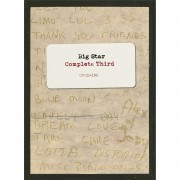The first thing I want to disclose before going further is to say that in the canon of the three albums Big Star, one of my favorite bands (and part of my Holy Trinity with The Beatles and The Who) recorded, Third isn’t one of my favorites – I know that’s heresy to more than a few. To me, #1 Record and Radio City were far more solid; they were “band” albums and Third was always a little too obtuse and disconnected for me. Yes, there are some songs that I love without reserve or hesitation – “Thank You, Friends”, “Kangaroo”, “Big Black Car” – but the overall feel and sound of the record always left me a little uncomfortable. At the same time, I know there are many others who do, in fact, share this view. It wasn’t so much of a “band” album as it was purely Alex Chilton’s drug-induced vision, etc., so to call it “Big Star” was something of a misnomer – maybe. Nonetheless, its weirdness was what always had me reverting back to the first two albums most often. The legend (as it were) behind this album; its recording process and attempts at putting together in a coherent manner a final running order, is also known to all. I don’t need to recount it or how it finally was released in two different forms in 1978 (in the United States on Marty Scott’s Jem Records/PVC imprint and in the U.K. on Aura records, both with different art), three years after recording but I can compare the whole story to only one other album shrouded in enigma and that, of course, would be The Beach Boys’ Smile.
But now, Omnivore Recordings, who do some of the most exquisite work with compilations and re-issues have finally given a sense of completion to Third; they’ve uncovered all the tapes in the vaults at Ardent Studios, the Memphis home base to Big Star, and have delivered a three-disc box set, Complete Third (a three separate release, double album set pressing will follow later). And I would make the argument, this is as complete as you can hope for. Housed in a long-book package with informative and riveting liner notes from (amongst several) Bud Scoppa, Pat Rainer, Chris Stamey and Peter Holsapple, the sound is remarkable (the 1993 Rykodisc release always sounded a little thin and tinny) and the thread of the songs is taut and tight so that, to me, the coherency that was lacking is now there. 69 tracks – 29 previously unheard – culled from the session recordings, demos and alternate mixes by both producer Jim Dickinson and Ardent owner/engineer John Fry – and in this manner, we, the listeners, can track the evolution of this album from the start of the process to the final mixes – Disc 3 is the presentation of the final mixes and sounds much cleaner, crisper and buoyant here than before.
Getting right to those mixes on the third disc, “Kizza Me” kicks loud and hard from the opening crash; “Nightime” you can hear Chilton’s voice with a greater feeling of confusion mixed with emotion (the raw “get me out of here/I hate it here”); “Jesus Christ” and “Thank You, Friends” are even more joyful and alive. “Big Black Car”, although its lyrics are not what one could call “happy”, sounds fresh and has a wonderfully cinematic feel that comes out of the speakers. “Kanga Roo” is more gripping than previously heard as “Holocaust” is bleaker and claustrophobic with those dry vocals up front. And the beauty and pure loving delivery of Jody Stephens’ “For You” sounds even more uplifting (for my money, I much prefer Jody’s vocals over Alex’ – heard on Disc 2). Of the unheard material, from the first disc of demos and sessions, a “band” version of “Big Black Car”, which taken in this version, does sound more like Big Star (that Chilton guitar sound/style); “Kizza Me” in this early run-through actually sounds fully formed and just needs the overdubs, double-tracked vocals and embellishments – yet, stripped down sounds as good. “Thank You, Friends” also sounds close to the finished version, minus the strings and backing vocals. The John Fry rough mix of “Kanga Roo” is powerful with the diminished feedback and elevated strings; the Jim Dickinson rough mix of “Holocaust” is equally gripping and is near the balance of the final mixed version.
I could continue on, trying to pick apart each song and attempt to describe what I’m hearing from this different perspective – I don’t know if that will give you any more impetus to go out and buy this boxset, but all I can say is this: it is rare, if not near impossible, for you or I to actually hear the complete genesis of an album. From its rawest demos to the run throughs to the roughs to the actually varied and then final mixes. This is a documented moment in musical history and because Big Star IS a monumentally important band in American rock history (let alone in the pantheon of rock history alone), you should want to know more – because this does complete a previously murky picture. As for me, I’ve gained a greater appreciation for Third; listening to it with fresh ears, fresh mixes and a fresh perspective is always the first solid steps towards understanding what I hadn’t really understood before. That at the end of the day – call it Big Star or whatever it was supposed to be – those are just some damned fine songs.
ESSENTIAL LISTENING – HIGHLY RECOMMENDED
Big Star: Complete Third will be available Friday, October 14th, 2016
http://omnivorerecordings.com/artist/big-star/






Comments